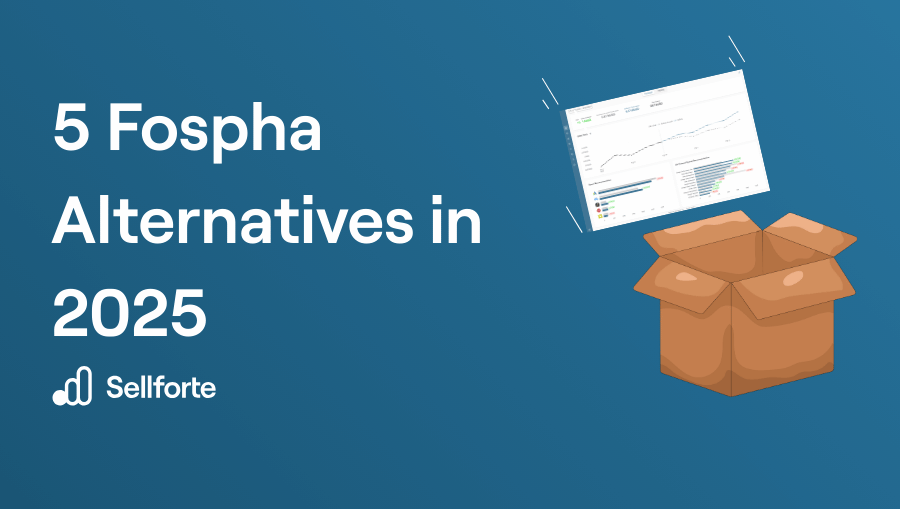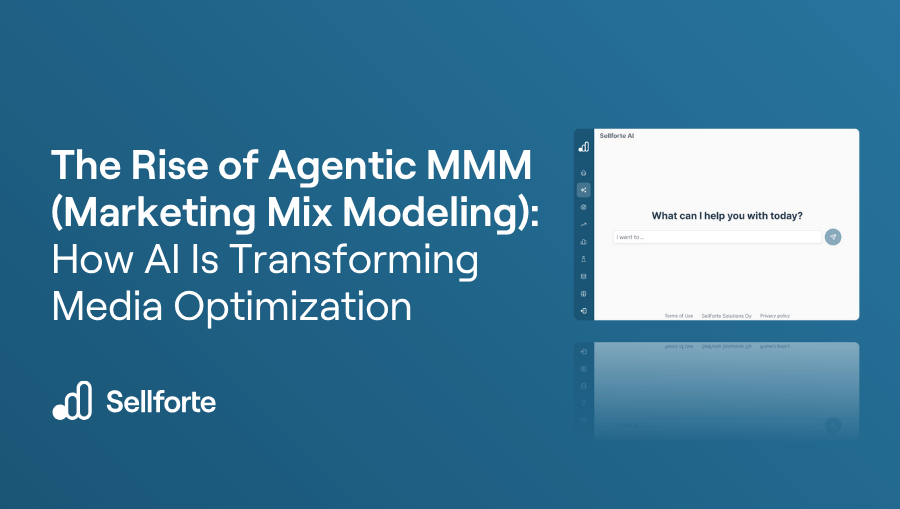The Five Requirements of Autonomous Media Buying and Optimization: M.A.G.I.C.
In October 2025, we launched Sellforte AI and Sellforte's vision for Autonomous Media Buying & Optimization. We envision a world where digital media buying is fully automated. A world, where marketers can drastically multiply their output and transition from manual bid value tinkering to tasks which human do best: strategy, objectives and creative work.
But what is required to build an Autonomous Media Buying & Optimization system? There's five fundamental requirements.
At Sellforte, we call these five requirements M.A.G.I.C. In this blog post, we will discuss the five letters of M.A.G.I.C. and provide an evaluation how different solutions today are fulfilling those requirements.

The Five Requirements of Autonomous Media Buying and Optimization: M.A.G.I.C.
The five letters of M.A.G.I.C. come from following concepts:
- M = Marginal Incremental ROAS (miROAS)
- A = Actionable (translates recommendations to bid values)
- G = Granular (campaign and ad set level)
- I = Incremental (understands true revenue impact of media)
- C = Cross-Platform (integrations to all major platforms)
Let's walk through each of them one by one.
M = Marginal Incremental ROAS (miROAS)
Marginal Incremental ROAS (miROAS) is used in media spend optimization to identify campaigns and ad sets which can scale further, and ones which deserve a spend cut.
This makes robust estimation of miROAS the foundation for any media spend optimization system. Unlike Incremental ROAS (iROAS), which is a KPI for average historical return for a certain time period, miROAS measures the return for the next spent dollar.
miROAS is a calculated from the Response Curve of the campaign or ad set, as illustrated in the picture below. miROAS is dynamic: it is dependent on the spend level on the campaign or ad set.

If miROAS is low, the campaign is saturated and spend should be decrease spend. If miROAS is high, the campaign has room to scale further, and spend should be increased.
Autonomous media buying & optimization system seeks to adjust spending to state where miROAS is the same for all campaigns and ad sets. In this state, there are no campaigns or ad sets that have higher or lower miROAS compared to others, and thus there are no analytical optimization actions left.
A = Actionable (Translates recommendations to bid values)
"Actionable" means that that the media buying & optimization system can translate miROAS-based optimization recommendations to bid value changes.
Why? Because digital media buying is executed in an auction system operated by each advertising platform. Bid value is the input to the ad platform for conducting buying. If bid values don't change, no optimization is done.
In the picture below, you can see Target ROAS setting for an Ad Group in Google Ads.

As an example, to increase spend of a Target ROAS campaign, an autonomous buying system might implement Target ROAS decrease from 4.5 to 4.0.
G = Granular (Campaign and ad set level)
"Granular" means that the autonomous media buying & optimization system needs to operate on campaign and ad set level.

After we discussed the campaign/ad set level bid values in the previous chapter, the requirement of granularity might seem obvious. Granular could actually be even the first requirement in the list.
However, being able to operate on campaign and set level is a very important distinction to make, because there are solutions which might provide media spend optimization, but they operate on a higher level. As an example, Traditional Marketing Mix Modeling can provide miROAS on an advertising platform or even channel level, but it is not sufficient for an autonomous media buying and optimization platform.
I = Incremental (not based on attribution)
"Incremental" means that the autonomous media buying & optimization system needs to distinguish between revenue that was actually driven by media and revenue that was driven by other factors.

This requirement makes sure that the system is able to measure the true revenue impact it's targeting to achieve with more optimized media spend allocation, so that for example promotion-driven sales or organic demand are not skewing the results. Incrementality-based measurement is also the basic building block of measuring miROAS.
In practice, all systems which have attribution-based measurement as their primary methodology fail this requirement because they are not able to distinguish between incremental and non-incremental revenue. As an example, last-click attribution captures a lot of conversions for branded search that would have occurred even without media.
C = Cross-Platform (Integrated to Google, Meta..)
"Cross-platform" means that the autonomous media buying & optimization system needs to be able measure and optimize across all the major advertising platforms, such as Google, Meta, TikTok, Microsoft Bing.

Ability to operate across all the advertising platforms enables spend re-allocation from one platform to another, which can be a major optimization lever. Even more importantly, integrations to as many platforms as possible enables the system to cover a maximally large part business's media spend.
Comparing Six Solutions and Their Readiness for Autonomous Media Buying
At this point, you're probably curious: which tools, solutions and methodologies can deliver all the letters of M.A.G.I.C.? This information is summarized in the table below, and next we'll walk through each of them.
Sellforte
Sellforte is currently the only platform in the world covering all five requirements of M.A.G.I.C.
M. (miROAS): Sellforte measures miROAS for each campaign and ad set.
A. (Actionable): Sellforte Performance recommends bid value changes for each campaign and ad set. Bid value recommendations are based on miROAS.
G. (Granular): Sellforte's insights are available on campaign and ad set level.
I. (Incremental): Leveraging Marketing Mix Modeling and Incrementality Tests / Experiments, Sellforte's insights are based on incrementality.
C. (Cross-Platform): Sellforte's insights are available across all platforms, and Sellforte can execute buying on multiple platforms.
Sellforte's customers currently use Sellforte in an assisted-drive mode, where the marketer (or agency) is provided optimal bid values that can be executed on the advertising platforms.
n 2026 Q1, Sellforte is launching a new AI Agent on it's Agentic MMM platform that brings fully autonomous media buying & optimization to the market: Media Buyer Agent.

Last-Click Attribution
Last-Click Attribution is typically the measurement approach small ecommerce businesses start with. It covers 2 out 5 requirements of an autonomous media buying & optimization system.
M. (miROAS): Last-Click Attribution measures backward-looking attributed Return On Ad Spend (ROAS), but does not measure miROAS.
A. (Actionable): Last-Click Attribution does not provide bid value recommendations.
G. (Granular): Last-Click Attribution can provide campaign-level measurement.
I. (Incremental): Last-Click Attribution is not capable of estimating the true revenue impact of media. The ROAS estimated by Last-Click Attribution severely deviates from incrementality-based estimates, as shown for example by this study: The 3 Danger Zones of Last-Click (And How to Avoid Them).
C. (Cross-Platform): Even if biased, Last-Click attribution provides ROAS estimates across platforms.
Example Last-Click Attribution tools: Google Analytics 4, Adobe Analytics
Multi-touch attribution
Larger companies might have Multi-Touch Attribution (MTA) in use to replace last-click attribution. However, it also covers only 2 out 5 requirements of an autonomous media buying & optimization system.
M. (miROAS): Multi-Touch Attribution measures backward-looking attributed Return On Ad Spend (ROAS), but does not measure miROAS.
A. (Actionable): Multi-Touch Attribution does not provide bid value recommendations.
G. (Granular): Multi-Touch Attribution can provide campaign-level measurement.
I. (Incremental): Multi-Touch Attribution is not capable of estimating the true revenue impact of media. While MTA often promises better coverage of the buying journey, our experience shows that it rarely significantly deviates from Last-Click Attribution.
C. (Cross-Platform): Even if biased, Multi-Touch Attribution provides ROAS estimates across platforms.
Example Multi-Touch Attribution tools: Triple Whale, Exactag, Fospha.
Ad Platform Attribution
The final attribution methodology on our list, Pixel-based Ad Platform attribution, has two main differences to MTA and Last-Click Attribution. While similarly granular, it is only able to operate on one platform, such as Meta. However, Ad Platform attribution is connected to the platforms' auction processes, making them capable of recommending bid value changes. Ad Platform Attribution covers 2 out 5 requirements for an autonomous media buying & optimization system.
M. (miROAS): Ad Platform Attribution measures backward-looking attributed Return On Ad Spend (ROAS), but does not measure miROAS.
A. (Actionable): Ad Platform attribution is connected to ad platform's auction process and has capabilities to recommend bid value changes.
G. (Granular): Ad Platform Attribution can provide campaign-level measurement.
I. (Incremental): Ad Platform Attribution is not capable of estimating the true revenue impact of media. ROAS measured by Ad Platforms is often inflated, because they often also capture conversions driven by other platforms, and conversions driven by other factors such as promotions.
C. (Cross-Platform): Ad Platform attribution focuses on one platform.
Example Ad Platform Attribution tools: Meta Pixel, Google Ads Tag
Traditional Marketing Mix Modeling
In our evaluation, Traditional Marketing Mix Modeling (MMM) is a complete inverse from ad platform attribution. It is operating on the principles and incrementality and can measure miROAS. The problem is that Traditional MMM-based measurement is operating on channel-level, which also means that MMM is not able to recommend bid value changes. Marketing Mix Modeling covers 3 out 5 requirements of an autonomous media buying & optimization system.
M. (miROAS): Traditional Marketing Mix Modeling can estimate miROAS on channel-level.
A. (Actionable): Traditional Marketing Mix Modeling does not recommend bid value changes.
G. (Granular): Traditional Marketing Mix Modeling provides measurement on channel level (e.g. Google Performance Max), and is not able to provide campaign or ad set level miROAS.
I. (Incremental): Marketing Mix Modeling methodology is aimed at estimated marketing's actual incremental revenue impact through time-series analysis.
C. (Cross-Platform): Marketing Mix Modeling aims at covering all media channels and platforms, so that they can be measured using a comparable ROI-metric.
Example Marketing Mix Modeling tools: Google Meridian. Find more MMM tools in our article: 25 Marketing Mix Modeling Tools for Accelerating Growth in 2026
Incrementality Testing
Similar to MMM, Incrementality Testing (such Geo Lift tests and Conversion Lift tests) is also an incrementality-based measurement methodology. Contrary to MMM, Incrementality Testing platforms and tools are not estimating miROAS. Inrementality testing covers 2 out 5 requirements for autonomous media buying & optimization system.
M. (miROAS): Incrementality Testing tools do not provide miROAS.
A. (Actionable): Incrementality testing tools do not recommend bid value changes.
G. (Granular): Incrementality tests focus on channel-level (e.g. Google Performance Max) measurement, and are not able to provide campaign or ad set level insights.
I. (Incremental): Incrementality tests aim at estimating marketing's actual incremental revenue impact through experiment-based setup.
C. (Cross-Platform): Incrementality tests can measure all media channels and platforms, even sufficient amount of testing is executed.
Example Incrementality Testing tools: Haus, Incrmntal.
Conclusions
The $800B digital media industry will move to autonomous media buying. It’s a question of when, not if.
For an autonomous media buying & optimization platform, you need M.A.G.I.C.:
- M = Marginal Incremental ROAS (provides miROAS)
- A = Actionable (translates recommendations to bid values)
- G = Granular (campaign and ad set level)
- I = Incremental (understands true revenue impact of media)
- C = Cross-Platform (integrations to all major platforms)
Most existing solutions are miles away from fulfilling M.A.G.I.C. Attribution-based tools fail at miROAS and incrementality. Traditional MMM and incrementality testing tools fail granularity and actionability.
Sellforte's platform already has M.A.G.I.C. built it today. To unleash the full vision of autonomous Media Buying & Optimization, Sellforte is launching its Automated Media Buying Agent in 2026 Q1.
The companies that adopt autonomous media buying & optimization early will operate with a compounding advantage: faster optimization cycles, better spend allocation, and time freed for the high-leverage work humans are actually good at: strategy, objective setting and creative work.
To learn more about Sellforte's Autonomous Media Buying & Optimization vision, book a demo.
You May Also Like
These Related Stories

5 Fospha Alternatives and Competitors in 2025

ROAS, iROAS, miROAS: Choosing the Right KPI for Optimizing Media Spend

